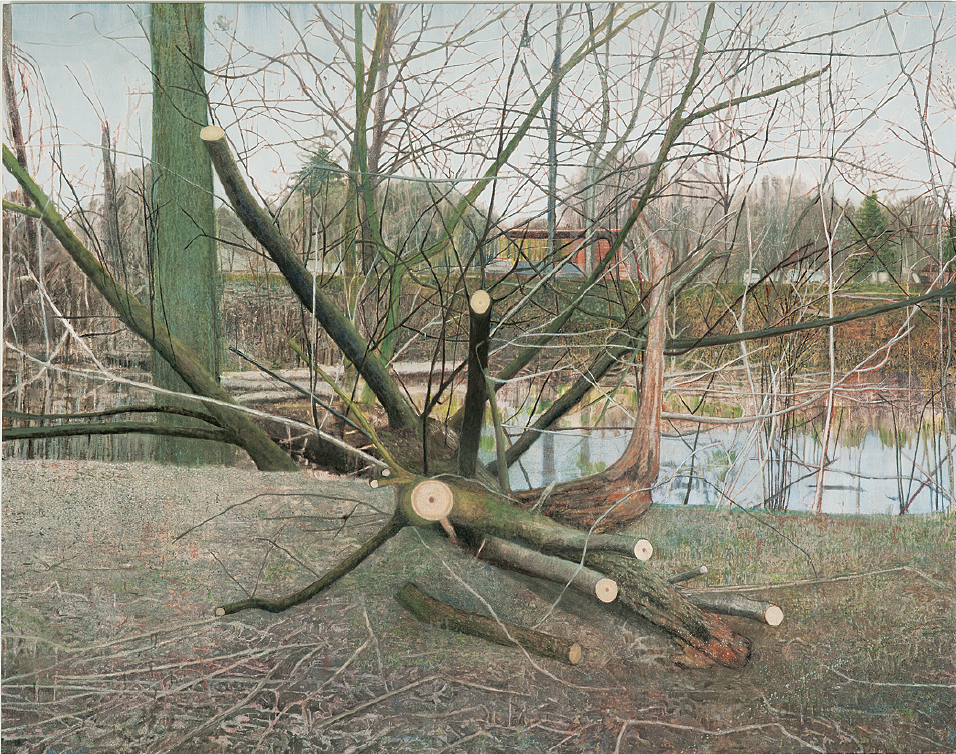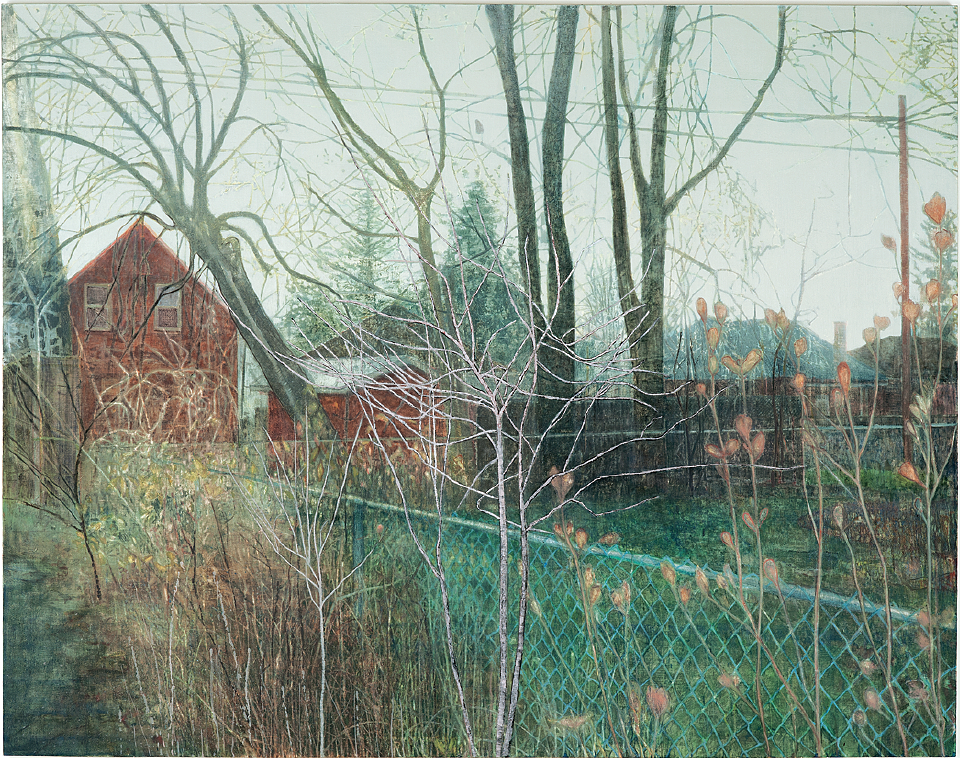Sky Glabush
“The Visible and the Invisible” gathers Sky Glabush’s paintings from the past three years. This body of work is a revelation in every sense of the word, though what it reveals is neither obvious nor comforting. The German philosopher Martin Heidegger reminds us that there is nothing natural about home. There is no somewhere else (preferably ideal) from which we’ve fallen into this world. Nor is this world—houses, cities, earth—our home. Heidegger calls this Geworfenheit, the sense of “being-thrown” into what philosopher and critical theorist Slavoj Žižek calls in On Belief, “a concrete historical situation.” As Žižek asks, “What if this dislocation is our constitutive, primordial condition, the very horizon of our being? What if there is no previous ‘home’ out of which we were thrown into this world, what if this very dislocation grounds man’s ex-static opening to the world?” This also means that home can be anywhere because it’s nowhere at all.
Glabush’s early flirtation with pure abstraction at his Mendel Art Gallery exhibition in 2001 shifted toward painting Modernist space as postmodern anonymity in his 2006 exhibition at the Douglas Udell Gallery in Edmonton. The sense of place that came with moving to London, Ontario, however, challenged Glabush to explore how painting “haunts the social imagination.” In the ’60s and ’70s London became an epicentre for regionalism in contemporary Canadian art. Glabush has no nostalgia for the “self-assured directness” of Chambers or Curnoe, which is for him only a “faint signal.” Rather, those two artists got him to ask, as he wrote in an artist’s statement, how the “syntax and history” of the pictorial needs to “find expression in the local and familiar.” By giving the local a history it never had, or knew it had (think of Alice Munro), painting holds the emphatic and the ephemeral—timeless stasis and absolute movement—in its uncertain grip. Paint and technique claim their region absolutely but also defamiliarize what they see, finding and losing reality on our behalf.

Sky Glabush, cut tree, 2011, oil on canvas, 84 x 108”. Courtesy the artist and MKG127, Toronto.
Upon moving to London, Glabush started making paintings of houses defiantly undistinguished and indistinguishable. Eight of the show’s 11 works depict houses as occupied spaces that can’t be occupied—houses that may or may not be homes. The conceit seems an apt metaphor for painting itself. We have the full-frontal assaults of two buildings together in blue house, 2008, or two versions of the same subject, new year, 2009, or white out, 2009—in all three cases, uncanny doubles that don’t add up to the same perception. In rain, 2009, like white out, atmosphere muddies things, a Seurat-like pointillism that coheres far away but breaks apart up close. This attempt to gain perspective achieves an almost sublime solitude in starry night, 2010, and cul de sac, 2009, perhaps the show’s centrepieces. Both are distant street scenes that at once harmonize and preclude community, the paint itself both embodying and liquefying the everyday (cul de sac includes a car and a human being, as if at once to parody and obviate the techne of painting itself).
Things change with backyard, 2010, and the beautiful sun weeds, 2010. Both approach their subjects obliquely, from behind dense entanglement, as if the houses are receding into nature. The striations of leafless trees and overgrown vegetation carve up the field with a kind of stark indeterminacy, offset by swatches of lush abstractness reminiscent of Peter Doig. Neither realism nor realist fantasy, these paintings overdetermine what the Group of Seven saw as painting’s natural effects to produce the fantasy of realism. The effect is to de-nature nature, to show nature itself its own uncanny homelessness.

Sky Glabush, sun weeds, 2010, oil on canvas, 7 x 9’. Photograph: Frank Piccolo, GXZ Design. Private Collection. Courtesy the artist and MKG127, Toronto.
Two works in the show epitomize this approach. Cut tree, 2011, depicts a felled tree, all branches removed, each cut turned toward the viewer like a series of targets. The painting figures figure itself as both natural occurrence and fetish suspended in the middle of painting’s alternate reality. Drainage, 2010, creates a similar uncanniness from the juxtaposition of an always decaying nature swallowing a drainage pipe in the painting’s bottom half and the glimmer of early morning light that lifts the trees back to life over a rooftop in the top half. The point is neither the toxic impact of human habitation nor the barbarity of nature; the point is for us to see how paint sees. As Glabush materializes his subjects through successive layers of drawing and paint, he also subtracts from the surface. The viewer can’t tell if culture recedes into nature or vice versa. The result is a kind of negative aura that figures painting’s “natural” ability to body forth the real. Painting reveals the world as a “nature” in which we are aliens to ourselves.
From home to nature, the paintings in “The Visible and the Invisible” throw us into a world in which we’re already thrown, homeless at home. They are at once intimate and anonymous, what Jacques Lacan calls the extimate. The extimate means what is neither outside nor inside, exterior nor intimate, self nor other—paint nor reality. Rather, the extimate figures the background or matrix in which reality exists, from which it emerges. Glabush’s paintings can’t and don’t distinguish ground from figure because at that impossible horizon, the paintings—we—both appear and vanish. The extimate bodies forth the vitality of death. But with the revelation of death comes revelation itself. Glabush doesn’t paint London, though London comprises the absolute necessity of his painting. Rather he paints the everyday, every day. This touches upon something eternal in every stage of its perception, the invisible within the visible. If it took coming to London for Glabush to have this revelation, we can, on the evidence of this remarkable show, be thankful for Glabush and London—for Glabush in London. ❚
“Sky Glabush: The Visible and the Invisible” was exhibited at the Art Gallery of Windsor, January 15 to March 6, 2011.
Joel Faflak teaches in the Department of English and the Centre for the Study of Theory and Criticism at the University of Western Ontario, London.

